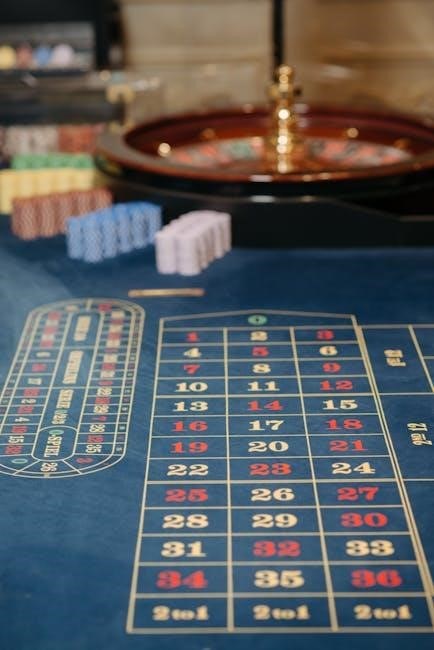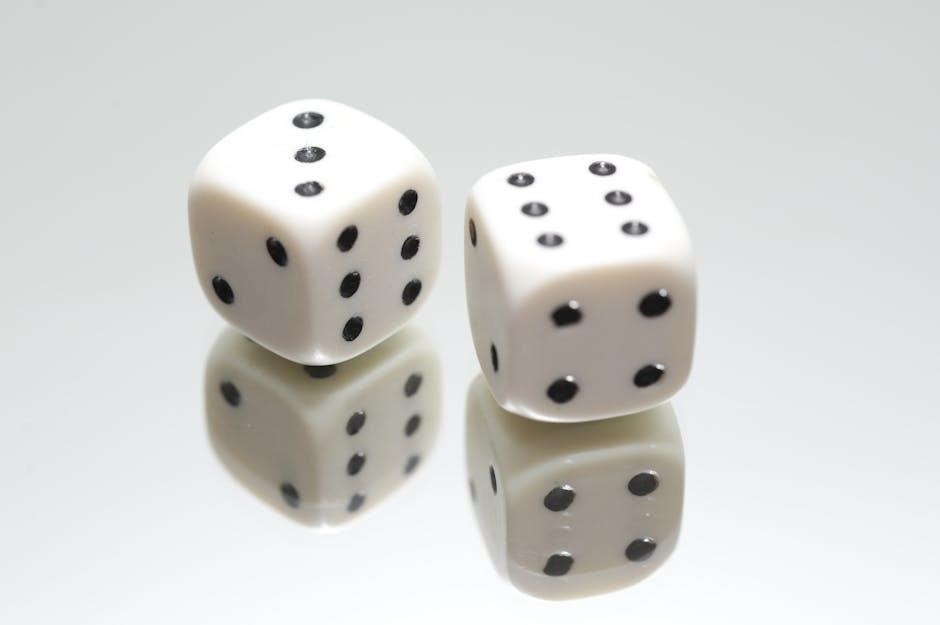Welcome to Grade 7 probability worksheets, designed to engage students in learning probability basics through interactive exercises and real-world applications. Perfect for classrooms and homeschooling, these resources cover essential concepts and practical probability problems, helping students build a strong foundation in math.

What Are Probability Worksheets?
Probability worksheets are educational resources designed to help students understand and practice probability concepts. They typically include exercises, problems, and activities that cover theoretical and experimental probability. These worksheets often feature interactive elements, such as spinning experiments, probability scales, and real-world scenarios, to engage learners. Many are available as printable PDFs, making them convenient for classrooms, homeschooling, or independent study. They cater to different learning styles and provide step-by-step guidance to ensure students grasp key probability principles, from basic to advanced levels.
Why Use Grade 7 Probability Worksheets?
Grade 7 probability worksheets are an excellent tool for teaching and reinforcing probability concepts. They provide structured exercises that cater to different learning styles, helping students grasp theoretical and experimental probability. These worksheets offer hands-on practice, making abstract ideas tangible. They also include real-world applications, such as weather forecasting and sports analytics, to highlight the relevance of probability in everyday life. By using these resources, students can build a strong foundation for advanced math and problem-solving skills, while teachers can easily track progress and understanding through the provided exercises and answer keys.

Basic Concepts of Probability
Probability is a number between 0 and 1 that shows the likelihood of an event happening. It helps predict outcomes in experiments like coin flips or dice rolls.
Theoretical Probability
Theoretical probability is the likelihood of an event occurring based on the number of favorable outcomes divided by the total number of possible outcomes. For example, when rolling a fair six-sided die, the probability of landing on 3 is 1/6 because there is one favorable outcome (rolling a 3) out of six possible outcomes (1, 2, 3, 4, 5, 6). This concept helps students understand and predict outcomes in fair and equal chance scenarios, forming the foundation for more complex probability problems. It is a key concept explored in Grade 7 probability worksheets.
Experimental Probability
Experimental probability is determined by conducting repeated trials of an experiment and observing the frequency of specific outcomes. For instance, rolling a die multiple times and recording the results helps estimate the likelihood of each outcome. Unlike theoretical probability, which is based on equally likely outcomes, experimental probability provides a practical approach to understanding chance events. Worksheets often include activities like spinning a spinner or flipping a coin to calculate experimental probabilities, allowing students to compare real-world results with theoretical expectations and develop a deeper understanding of probability concepts through hands-on learning experiences.

Key Topics Covered in Grade 7 Probability Worksheets

Grade 7 probability worksheets cover single event probability, multiple event probability, spinner experiments, and comparing experimental and theoretical probability, ensuring a comprehensive understanding of probability concepts.

Understanding Single Event Probability
Single event probability focuses on the likelihood of a specific event occurring in one trial. For example, rolling a 3 on a die or flipping a coin to get heads. Students learn to calculate probability by dividing the number of favorable outcomes by the total number of possible outcomes. Worksheets include exercises like determining the probability of drawing a blue marble from a bag or selecting a red card from a deck. These activities help students grasp basic probability concepts and apply them to real-world scenarios, such as weather forecasting or game outcomes. Mastering single event probability is essential for understanding more complex probability problems.
Understanding Multiple Event Probability
Multiple event probability explores the likelihood of two or more events occurring together. Worksheets often include problems like flipping a coin twice or rolling a die multiple times. Students learn to calculate probabilities for independent events, where the outcome of one event does not affect another, and dependent events, where outcomes are influenced by previous events. For example, drawing marbles from a bag without replacement demonstrates dependent probability. These exercises help students understand how to apply probability rules to real-life situations, such as sports analytics or weather forecasting, and build a strong foundation for advanced probability concepts.
Spinner Experiments
Spinner experiments are a fun and interactive way for students to explore probability concepts. Worksheets often include spinners divided into sections with numbers or colors, allowing students to conduct trials and calculate probabilities. For example, a spinner divided into four equal sections (1, 2, 3, 4) helps students determine the probability of landing on an even number or a specific color. These activities make learning engaging and help students visualize how theoretical probability applies to real-world experiments, fostering a deeper understanding of chance events and their likelihoods. Spinner experiments are a key part of probability education in Grade 7.

Comparing Experimental and Theoretical Probability
Comparing experimental and theoretical probability helps students understand the relationship between predicted and actual outcomes. Theoretical probability is calculated based on all possible outcomes, while experimental probability is determined through repeated trials. Worksheets often include exercises where students conduct experiments, such as rolling dice or spinning spinners, and then compare their results to the expected probabilities. This comparison allows students to see how closely their experimental results align with theoretical predictions, enhancing their grasp of probability concepts and the law of large numbers. This hands-on approach makes learning dynamic and relatable for Grade 7 students.

Real-World Applications of Probability
Probability is used in sports, weather forecasting, and games, helping predict outcomes. These real-world examples make learning engaging and relevant for Grade 7 students.
Probability in Sports and Games
Probability plays a crucial role in sports and games, allowing players and fans to predict outcomes. For instance, calculating the chance of winning a game or scoring a goal helps strategize. In basketball, experimental probability can determine a player’s likelihood of making a free throw based on past performance. Similarly, in card games, understanding probability aids in making informed decisions. These real-life applications make probability concepts engaging and practical for Grade 7 students, connecting math to their everyday interests and hobbies through interactive worksheets.
Probability in Weather Forecasting
Probability is essential in weather forecasting, where it predicts the likelihood of events like rain or sunshine. Meteorologists use percentages, such as a 30% chance of rain, to convey uncertainty. This application helps students understand probability in real-world scenarios. Worksheets often include problems where students calculate probabilities based on weather data, enhancing their ability to interpret forecasts. By analyzing such examples, students grasp how probability informs decision-making in everyday life, making math relatable and practical for future use;

How to Find Grade 7 Probability Worksheets
Grade 7 probability worksheets are easily accessible online as free PDFs. Visit educational websites or platforms offering math resources to download and print them conveniently.
Free Online Resources
Grade 7 probability worksheets are widely available online as free resources. Websites like Quizizz and cuemath.com offer downloadable PDFs with interactive exercises and answer keys. These worksheets cover topics such as theoretical and experimental probability, single and multiple events, and spinner experiments. They are designed to engage students with real-world applications, making learning fun and practical. Teachers and parents can easily access these materials to supplement classroom lessons or homeschooling. Many platforms also provide printable versions, ensuring convenience for offline use. These resources are ideal for reinforcing probability concepts and developing problem-solving skills in young learners.
PDF Worksheets
Grade 7 probability worksheets in PDF format are excellent resources for teaching and learning. They include a variety of exercises, such as calculating theoretical and experimental probabilities, understanding single and multiple events, and conducting spinner experiments. Many PDFs come with answer keys, making them ideal for self-assessment. These worksheets are printable, allowing students to practice offline and reinforce their understanding of probability concepts. They are widely available for free on educational websites, offering a convenient way to supplement classroom lessons or homeschooling activities. PDF worksheets are a valuable tool for engaging students and ensuring they master probability fundamentals.
Grade 7 probability worksheets are essential tools for mastering probability concepts. They provide interactive learning, real-world applications, and practical exercises, ensuring students grasp foundational math skills effectively.
Benefits of Using Probability Worksheets

Grade 7 probability worksheets offer numerous benefits, enhancing students’ understanding of probability concepts through interactive exercises and real-world applications. They provide a structured approach to learning, making abstract ideas more tangible. Worksheets encourage critical thinking and problem-solving skills, preparing students for advanced math. Additionally, they serve as valuable resources for teachers and parents, offering supplementary materials to reinforce classroom lessons. With their clear instructions and practical problems, probability worksheets help students apply probability to everyday situations, fostering a deeper appreciation for mathematics and its real-world relevance.
Mastering Probability for Future Success
Mastery of probability at the Grade 7 level is crucial for future academic success, as it forms the foundation for advanced math and science. By using probability worksheets, students gain a solid understanding of theoretical and experimental probability, enabling them to approach complex problems with confidence. These skills are essential for higher-level mathematics, including statistics and algebra. Moreover, understanding probability enhances critical thinking and decision-making abilities, which are valuable in real-world scenarios. With consistent practice using worksheets, students can build a strong mathematical foundation, preparing them for challenges ahead.
